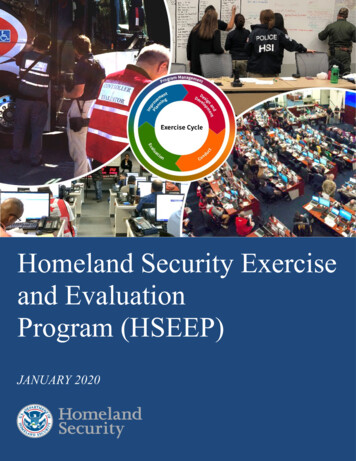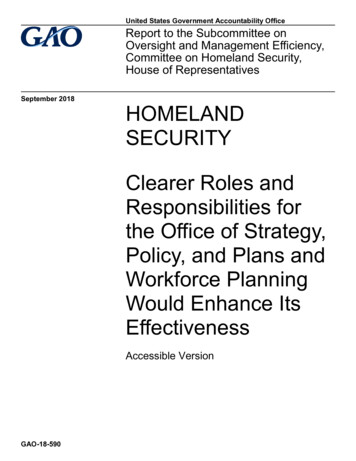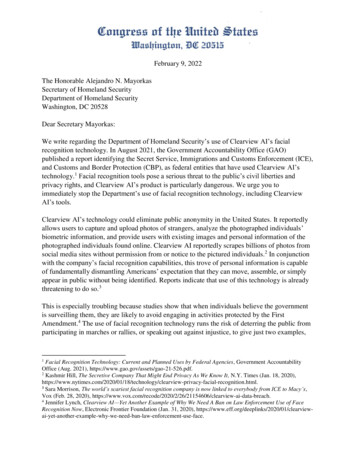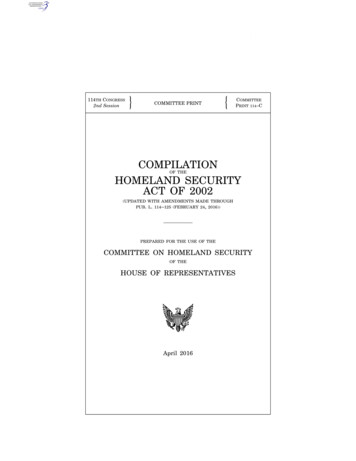
Transcription
Homeland Security Exerciseand EvaluationProgram (HSEEP)JANUARY 2020
Homeland Security Exercise and Evaluation ProgramTable of ContentsINTRODUCTION. VPURPOSE. VROLE OF EXERCISES . VAPPLICABILITY AND SCOPE . VISUPERSESSION . VIDOCTRINE ORGANIZATION . VIREVISION PROCESS . VIITOOLS . VIITRAINING . VII1.HOMELAND SECURITY EXERCISE AND EVALUATION PROGRAM (HSEEP)FUNDAMENTALS . 1-1OVERVIEW. 1-1FUNDAMENTAL PRINCIPLES . 1-1THE HOMELAND SECURITY EXERCISE AND EVALUATION PROGRAM (HSEEP) CYCLE . 1-2Program Management . 1-2Exercise Design and Development . 1-2Exercise Conduct . 1-2Exercise Evaluation . 1-2Improvement Planning . 1-22.PROGRAM MANAGEMENT . 2-1OVERVIEW. 2-1INTEGRATED PREPAREDNESS CYCLE . 2-1LINKAGE OF INTEGRATED PREPAREDNESS CYCLE AND HOMELAND SECURITY EXERCISE ANDEVALUATION PROGRAM (HSEEP) . 2-2ENGAGE SENIOR LEADERS . 2-2PREPAREDNESS PRIORITIES . 2-2INTEGRATED PREPAREDNESS PLANNING WORKSHOP (IPPW) . 2-3Purpose . 2-3Participation. 2-3Conduct of the Integrated Preparedness Planning Workshop (IPPW) . 2-4INTEGRATED PREPAREDNESS PLAN (IPP) . 2-5Progressive Approach . 2-5Discussion-Based Exercises . 2-6Operations-Based Exercises. 2-9PROGRAM REPORTING . 2-11MANAGE EXERCISE PROGRAM RESOURCES . 2-12Exercise Budget Management . 2-12Staffing. 2-12Other Resources . 2-123.EXERCISE DESIGN AND DEVELOPMENT . 3-1i
Homeland Security Exercise and Evaluation ProgramOVERVIEW. 3-1EXERCISE FOUNDATION . 3-1EXERCISE PLANNING ACTIVITIES . 3-2Exercise Planning Meetings . 3-2EXERCISE PLANNING TEAM CONSIDERATIONS . 3-7Exercise Planning Team Positions . 3-7EXERCISE DESIGN . 3-10Exercise Purpose . 3-10Exercise Scope . 3-10Exercise Objectives . 3-11Evaluation Parameters . 3-12Scenario . 3-12Exercise Documentation. 3-13Planning for Media and Public Affairs . 3-16EXERCISE DEVELOPMENT. 3-16Discussion-Based Exercise Logistics Planning . 3-17Discussion-Based Exercise Facilitation Planning . 3-18Operations-Based Exercise Logistics Planning . 3-19Operations-Based Exercise Control Planning . 3-21Planning for Exercise Evaluation . 3-25Preparing for Exercise Conduct. 3-254.EXERCISE CONDUCT . 4-1OVERVIEW. 4-1DISCUSSION-BASED EXERCISES . 4-1Exercise/Play Preparation . 4-1Exercise Play/Conduct . 4-1OPERATIONS-BASED EXERCISES . 4-3Play Preparation . 4-3Exercise Play/Conduct . 4-4BRIEFINGS . 4-6WRAP-UP ACTIVITIES . 4-7Player Hotwash . 4-7Debrief . 4-75.EXERCISE EVALUATION . 5-1OVERVIEW. 5-1EVALUATION PLANNING . 5-1Evaluation Team. 5-2Evaluation Documentation . 5-3Exercise Evaluation Guide (EEG) Development . 5-4OBSERVATION AND DATA COLLECTION . 5-5Observation . 5-5Data Collection . 5-6DATA ANALYSIS. 5-7Data Synthesis . 5-7Event Reconstruction . 5-7ii
Homeland Security Exercise and Evaluation ProgramTrend Analysis . 5-8Root Cause Analysis . 5-8AFTER-ACTION REPORT (AAR)/IMPROVEMENT PLAN (IP) . 5-8AFTER-ACTION MEETING (AAM) . 5-10IMPROVEMENT PLAN (IP) . 5-106.IMPROVEMENT PLANNING . 6-1OVERVIEW. 6-1SMART CORRECTIVE ACTIONS . 6-1CORRECTIVE ACTION TRACKING AND IMPLEMENTATION . 6-2IMPROVEMENT PLANNING TO SUPPORT CONTINUOUS IMPROVEMENT . 6-3ACRONYMS . Acronym-1GLOSSARY OF TERMS . Glossary-1List of TablesTABLE 2.1: FACTORS FOR CONSIDERATION IN DEVELOPING EXERCISE PROGRAM PRIORITIES . 2-4TABLE 2.2: CONDUCT OF THE INTEGRATED PREPAREDNESS PLANNING WORKSHOP (IPPW) . 2-4TABLE 2.3: DISCUSSION-BASED EXERCISE TYPES: SEMINAR. 2-6TABLE 2.4: DISCUSSION-BASED EXERCISE TYPES: WORKSHOP . 2-7TABLE 2.5: DISCUSSION-BASED EXERCISE TYPES: TABLETOP EXERCISE . 2-7TABLE 2.6: DISCUSSION-BASED EXERCISE TYPES: GAME . 2-8TABLE 2.7: OPERATIONS-BASED EXERCISE TYPES: DRILL . 2-9TABLE 2.8: OPERATIONS-BASED EXERCISE TYPES: FUNCTIONAL EXERCISE . 2-10TABLE 2.9: OPERATIONS-BASED EXERCISE TYPES: FULL-SCALE EXERCISE. 2-11TABLE 3.1: PLANNING MEETING TYPES: CONCEPT AND OBJECTIVES (C&O) MEETING . 3-2TABLE 3.2: PLANNING MEETING TYPES: INITIAL PLANNING MEETING (IPM) . 3-3TABLE 3.3: PLANNING MEETING TYPES: MIDTERM PLANNING MEETING (MPM) . 3-4TABLE 3.4: PLANNING MEETING TYPES: MASTER SCENARIO EVENTS LIST (MSEL) MEETING . 3-5TABLE 3.5: PLANNING MEETING TYPES: FINAL PLANNING MEETING (FPM) . 3-6TABLE 3.6: FUNCTIONS OF AN EXERCISE PLANNING TEAM. 3-8TABLE 3.7: ELEMENTS THAT DEFINE SCOPE . 3-10TABLE 3.8: DISCUSSION-BASED EXERCISE DOCUMENTATION . 3-13TABLE 3.9: OPERATIONS-BASED EXERCISE DOCUMENTATION . 3-14TABLE 3.10: OTHER EXERCISE DOCUMENTATION . 3-15TABLE 3.11: POSITIONS OF AN EXERCISE FACILITATION STRUCTURE . 3-19TABLE 3.12: FACILITIES AND EXERCISE AREAS, DESCRIPTIONS, AND TYPES. 3-20TABLE 3.13: POSITIONS OF AN OPERATIONS-BASED EXERCISE CONTROL STRUCTURE . 3-22TABLE 3.14: MSEL EVENT TYPES . 3-23TABLE 4.1: POSITIONS OF A DISCUSSION-BASED EXERCISE CONTROL STRUCTURE . 4-2TABLE 4.2: POSITIONS OF AN OPERATIONS-BASED EXERCISE CONTROL STRUCTURE . 4-5TABLE 4.3: TYPES OF EXERCISE BRIEFS. 4-6TABLE 5.1: POSITIONS OF AN EXERCISE EVALUATION TEAM . 5-3TABLE 5.2: EVALUATION DOCUMENTATION . 5-3TABLE 5.3: DATA COLLECTION METHODS . 5-6TABLE 5.4: CATEGORIES OF AN AAR/IP OBSERVATION . 5-9iii
Homeland Security Exercise and Evaluation ProgramTABLE 5.5: AFTER-ACTION MEETING . 5-10List of FiguresFIGURE 1.1: THE HSEEP CYCLE. 1-2FIGURE 2.1: THE INTEGRATED PREPAREDNESS CYCLE . 2-1FIGURE 2.2: THE RELATIONSHIP OF THE INTEGRATED PREPAREDNESS CYCLE AND THE HSEEPCYCLE. 2-2FIGURE 3.1: INDIVIDUAL EXERCISE DESIGN AND DEVELOPMENT PROCESS . 3-1FIGURE 3.2: EXAMPLE OF A FUNCTIONAL ORGANIZATIONAL STRUCTURE FOR AN EXERCISEPLANNING TEAM. 3-8FIGURE 3.3: PRIORITIES, OBJECTIVES, AND CAPABILITIES . 3-11FIGURE 3.4: SMART GUIDELINES FOR EXERCISE OBJECTIVES. 3-12FIGURE 3.5: EXAMPLE OF A DISCUSSION-BASED EXERCISE FACILITATION STRUCTURE . 3-19FIGURE 3.6: EXAMPLE OF AN OPERATIONS-BASED EXERCISE CONTROL STRUCTURE . 3-22FIGURE 4.1: EXAMPLE OF A DISCUSSION-BASED CONTROL STRUCTURE . 4-2FIGURE 4.2: EXAMPLE OF AN OPERATIONS-BASED EXERCISE CONTROL STRUCTURE . 4-4FIGURE 5.1: EXITING THE HSEEP CYCLE AND ENTERING THE INTEGRATED PREPAREDNESS CYCLE. 5-1FIGURE 5.2: EXAMPLE OF AN EXERCISE EVALUATION TEAM . 5-2FIGURE 5.3: DEVELOPMENT OF AN EXERCISE EVALUATION GUIDE (EEG) . 5-4FIGURE 6.1: EXITING THE HSEEP CYCLE AND ENTERING THE INTEGRATED PREPAREDNESS CYCLE. 6-1FIGURE 6.2: SMART GUIDELINES FOR CORRECTIVE ACTIONS . 6-2iv
Homeland Security Exercise and Evaluation ProgramIntroductionPurposeThe Homeland Security Exercise and Evaluation Program (HSEEP) provides a set of fundamentalprinciples for exercise programs, as well as a common approach to program management, designand development, conduct, evaluation, and improvement planning. Exercises are an importantcomponent of preparedness, by providing the whole community 1 with the opportunity to shapeplanning, assess and validate capabilities, 2 and address areas for improvement. An exercise is anevent or activity, delivered through discussion or action, to develop, assess, or validate plans,policies, procedures, and capabilities that jurisdictions/organizations can use to achieve plannedobjectives.Through HSEEP, exercise program managers can develop, execute, and evaluate exercises thataddress the priorities established by a jurisdiction’s/organization’s senior leaders. The NationalPreparedness Goal, 3 strategy documents, Threat and Hazard Identification and Risk Assessment(THIRA) processes, capability assessments, and results from previous exercises and real-worldincidents impact the priorities. These priorities guide the overall direction of an exercise programwhere individual exercises anchor to a common set of priorities or objectives, which increase incomplexity over time. These priorities guide the design and development of individual exercisesand allow planners to identify and align objectives to the capabilities being evaluated. Exerciseevaluation assesses the ability to meet the objectives and capabilities by documenting strengths,areas for improvement, capability performance, and corrective actions in an After-Action Report(AAR)/Improvement Plan (IP).Through Improvement Planning, jurisdictions/organizations take the corrective actions identifiedduring exercises to improve plans, build and sustain capabilities, and maintain readiness.Stakeholders are reminded of the importance of implementing corrective actions.In this way, the use of HSEEP—in line with the National Preparedness Goal, the NationalPreparedness System (NPS), 4 and stakeholder preparedness priorities—supports efforts across thewhole community that improve the nation’s capacity to build, sustain, and deliver capabilities tobetter respond to a real-world incident.Role of ExercisesExercises play a vital role in preparedness. A well-designed exercise provides a low-riskenvironment to familiarize personnel with roles and responsibilities; foster meaningful interactionand communication across jurisdictions/organizations; assess and validate plans, policies,procedures, and capabilities; and identify strengths and areas for improvement. Exercises bringtogether and strengthen the whole community to prevent, protect against, mitigate, respond to, and1The whole community means involving people (individuals and families, including those with access and functional needs, businesses, faithbased and community organizations, nonprofit groups, schools and academia, media outlets, and all levels of government including state, local,tribal, territorial, and federal partners) in the development of national preparedness documents and ensuring their roles and responsibilities arereflected in the content of the materials.2Capabilities are the means to accomplish a mission, function, or objective based on the performance of related tasks, under specified conditions,to target levels of performance. For additional information on the core capability development sheets see eets.3Refer to the National Preparedness Goal: efer to the National Preparedness System: v
Homeland Security Exercise and Evaluation Programrecover from all hazards. Overall, exercises help the whole community address the prioritiesestablished by a jurisdiction’s/organization’s leaders; and evaluate progress towards meetingpreparedness goals.Applicability and ScopeThe HSEEP doctrine is flexible, scalable, adaptable, and for use by stakeholders across the wholecommunity and all mission areas. Using HSEEP supports the NPS by providing a consistentapproach to exercises and measuring progress toward building, sustaining, and deliveringcapabilities. To achieve whole community preparedness goals, agencies, jurisdictions/organizations, and stakeholders (for example, public health, transportation, education, etc.) that donot use the core capabilities as outlined in the National Preparedness Goal should use their relevantcapabilities and elements to better prepare for real-world incidents.The foundation of the HSEEP doctrine incorporates lessons learned and best practices from theexercise community and current policies and plans that support training, technology systems, tools,and technical assistance. Exercise practitioners are encouraged to apply and adapt the HSEEPdoctrine to meet their specific needs.SupersessionThe 2020 iteration of the HSEEP doctrine supersedes the 2013 version.Doctrine OrganizationThe organization of the HSEEP doctrine follows: Chapter 1, Homeland Security Exercise and Evaluation Program (HSEEP)Fundamentals, describes the basic principles and methodology of HSEEP. Chapter 2, Program Management, provides guidance for overseeing and integrating avariety of exercises over time, conducting an Integrated Preparedness Planning Workshop(IPPW), and developing a multi-year Integrated Preparedness Plan (IPP). Chapter 3, Exercise Design and Development, describes the methodology for developingexercise objectives, conducting planning meetings, developing exercise documentation,and planning for exercise logistics, control, and evaluation. Chapter 4, Exercise Conduct, provides guidance on setup, exercise play, and wrap-upactivities. Chapter 5, Exercise Evaluation, provides the approach to exercise evaluation planningand conduct through data collection, analysis, and development of an After-Action Report(AAR). Chapter 6, Improvement Planning, addresses corrective actions identified in the exerciseImprovement Plan and the process of tracking corrective actions to resolution.vi
Homeland Security Exercise and Evaluation ProgramRevision ProcessThe Department of Homeland Security’s Federal Emergency Management Agency’s (FEMA’s)National Exercise Division reviews the HSEEP doctrine and methodology every six years, or asneeded.ToolsThe Preparedness Toolkit (PrepToolkit) is a web-based application that allows the wholecommunity access to a wide variety of resources to manage preparedness activities. The system isdesigned to support implementation of the NPS by providing exercise planners, programmanagers, resource typing and mutual aid coordinators, threat and hazard planners, and other keystakeholders access to technologies that align to the six NPS elements. PrepToolkit supplies atechnology platform that supports implementation of HSEEP and aids exercise planners inprogram management, design and development, conduct, evaluation, and improvement planning.Refer to https://preptoolkit.fema.gov/hseep-resources for more information.TrainingTraining provides the whole community with the knowledge, skills, and abilities needed to performkey tasks required by specific capabilities. Jurisdictions/organizations should make trainingdecisions based on information derived from the assessments, strategies, and plans developed inprevious steps of the Integrated Preparedness Cycle. The National Training Program provides anorganized approach to training for emergency managers and emergency response providers acrossthe nation that supports the National Preparedness Guidelines. 5 The National Preparedness OnlineCourse Catalog provides searchable, integrated information on courses provided or managed byFEMA’s Center for Domestic Preparedness (CDP), the Emergency Management Institute (EMI),the National Fire Academy, and the National Training and Education Division (NTED). 65For more information on the National Preparedness Guidelines refer to: s/16886.For more information on training refer to:https://www.fema.gov/training, https://www.firstrespondertraining.gov/frts, and https://www.usfa.fema.gov/training/nfa/.6vii
Homeland Security Exercise and Evaluation Program1. Homeland Security Exercise and EvaluationProgram (HSEEP) FundamentalsOverviewThe HSEEP doctrine consists of fundamental principles that frame a common approach toexercises. The intent is to enhance consistency in exercise conduct and evaluation while ensuringexercises remain a flexible, accessible way to improve our preparedness across the nation.Fundamental PrinciplesApplying the following principles to the management of an exercise program and executingindividual exercises is important to an effective evaluation of capabilities: Senior Leader Guidance: The early and frequent engagement of senior leaders is the keyto the success of any exercise program. Senior leaders provide the overarching guidanceand direction for the exercise and evaluation program as well as specific intent forindividual exercises. Informed by Risk: Identifying and assessing risks and associated impacts helpsjurisdictions/organizations identify and evaluate priorities, objectives, and capabilitiesthrough exercises. Capability-Based, Objective-Driven: Jurisdictions/Organizations can use exercises toevaluate current capability levels/targets and identify gaps. Exercises focus on assessingperformance against capability-based objectives. Progressive Exercise Planning Approach: A progressive approach includes the use ofvarious exercises aligned to a common set of program priorities and objectives with anincreasing level of complexity over time. Progressive exercise planning does not alwaysimply a linear progression of exercise types. Whole Community Integration: The use of HSEEP encourages exercise planners, whereappropriate, to engage the whole community throughout program management, design anddevelopment, conduct, evaluation, and improvement planning. Common Methodology: HSEEP includes a common methodology for exercises across allmission areas. The methodology enables jurisdictions/organizations a sharedunderstanding of program management, design and development, conduct, evaluation, andimprovement planning and fosters exercise-related interoperability and collaboration.1-1
Homeland Security Exercise and Evaluation ProgramThe Homeland(HSEEP) CycleSecurityE x e rc i s eandEvaluationProgramHSEEP uses a common approach for planning, conducting,and evaluating individual exercises. The following chapterscontain more detailed descriptions of each phase, asdepicted in Figure 1.1.Program ManagementProgram management involves a collaborative approachthat integrates resources, jurisdictions/organizations, andindividuals to identify and achieve program priorities. Aneffective exercise program maximizes efficiency,resources, time, and funding by ensuring a coordinated andintegrated approach to building, sustaining, and deliveringcapabilities. Through the management of an exerciseprogram, senior leaders provide oversight for specificpreparedness activities sustained over time.Figure 1.1: The HSEEP CycleExercise Design and DevelopmentDuring exercise design and development, the exercise planning team members use the intent andguidance of senior leaders and the program priorities to shape the individual or series of exercises.Involving the risk and hazard assessments, plans, policies, and procedures, grant or cooperativeagreements, and relevant After-Action Reports (AARs) and Improvement Plans (IPs), exerciseplanners ensure that exercises assess and validate a jurisdiction’s/organization’s capabilities.Exercise ConductExercise conduct involves activities such as preparing for exercise play, managing exercise play,and conducting immediate exercise wrap-up activities. For a discussion-based exercise, conductentails presentation, facilitation, and discussion. For an operations-based exercise, conduct,encompasses all operations occurring between the designated Start of the Exercise (StartEx) andEnd of the Exercise (EndEx).Exercise EvaluationAn effective evaluation assesses performance against exercise objectives and identifies anddocuments strengths and areas for improvement relative to capabilities. Evaluation is importantand considered in all phases of the exercise planning cycl
Homeland Security Exercise and Evaluation Program v Introduction Purpose The Homeland Security Exercise and Evaluation Progr am (HSEEP) provides a set of fundamental principles for exercise programs, as well as a common approach to program management, design and de










